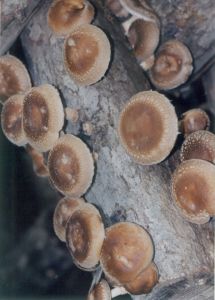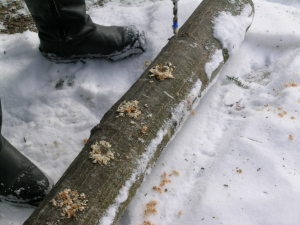Growing Mushrooms
I’ve been growing mushrooms outdoors on logs for about 20 years. I’ve done this by inoculating logs with little wooden plugs called plug spawn that I purchased and inserted into holes I drilled in the logs. Then I let them develop in the shade of a hemlock tree where they generally produce mushrooms in a year or less. Pretty easy. The best time to cut logs for growing mushrooms is late winter or early spring when the sap begins to run, so I am thinking about getting some logs soon and starting another batch. After all, there isn’t much else I can do in the garden for months.
The first step in the process of growing mushroom is finding logs that are appropriate for the mushrooms you want to grow. I have used oak and poplar for growing shiitake mushrooms, but according to Paul Stamets’ book, Mycelium Running: How Mushrooms Can Help Save the World, almost any deciduous tree species is fine for shiitakes, the mushrooms I have grown in the past. Pine, hemlock and other conifers are not recommended.
The logs you plan to use to raise shiitakes or other mushrooms need to be fresh. If you were to go in the woods and find a downed tree, it probably would already have fungi growing in the wood (mushrooms are the fruiting bodies of fungi). So you need to cut down a living tree (or better yet, have a person skilled with a chain saw cut it down for you). Or call up someone who sells firewood and explain what you want: logs 3 to 4 feet long and 4 to 8 inches in diameter that are freshly cut.
In the past I have most often inoculated poplar logs because the trees are fast growing, and I always have some ‘volunteers’ that need to be removed. Oaks are the species most commonly colonized by shiitakes in their native habitat of Japan, and produce for a longer time than poplar, but take longer to produce their first flush of mushrooms – up to 14 months. And they are a tree species I value, so it’s harder to sacrifice one.
I learned from Mycelium Running that not just shiitakes can be raised on logs. These species will also work, and are available from Stamets’ web site, www.fungi.com: Reishi, Maitake, Lion’s Mane, Pearl, Blue and Phoenix Oyster, Chicken of the Woods and Turkey Tail.
So how do I inoculate my logs? Using a 5/16-inch drill bit, I drill lines of holes about 8 inches apart from one end to the other. Then I drill another row of holes 4 to 6 inches from the first row. I stagger the holes so they don’t line up next to each other, from row to row. Then, with a hammer, I tap in the spore plugs that I have purchased. The holes should go a bit deeper into the wood than the length of the plug.
Finally, I melt some food grade wax (or natural bee’s wax) and paint the ends of the plugs. The wax prevents insects and bacteria that might consume the inoculant before the mycelium (fungal roots) extend and colonize the log. I have also tried inserting thimble spawn, which is made out of sawdust and has an attached Styrofoam cap. I find these are less satisfactory, as the caps do not always stay attached.
Paul Stamets is a self-avowed mushroom freak. He loves everything about them, and has found ways to grow edible and medicinal mushrooms, starting from wild harvested mushrooms. He describes several interesting ways of growing mushroom that I have not tried, but might this summer. Obviously I will only use mushrooms for propagation that I have had positively identified by a mushroom expert – some mushroom are deadly poisonous.
He describes inoculating piles of wood chips, burlap bags of wood chips and layers of cardboard, starting with what he calls “stem butts” from wild mushrooms. He digs up some of the root-like structures attached to the mushroom, along with the mushroom, and then cuts the edible portion off an inch or so above ground level. This “stem butt” is then put into a pile of woodchips or between layers of moist cardboard. The fungi quickly colonize the substrate, producing mycelium that will, when moved to an appropriate substrate, produce mushrooms.
Stamets’ book also describes how to start mushrooms by placing the stem butts into burlap bags of fresh wood chips. He notes that the chips should be free of wild spores, a problem if you just grab chips from a pile of wood chips that has been around for some time.
Finally, and this idea really grabs me, Mycelium Running suggest that you can inoculate stumps with plug spawn right after a tree has been cut down. This allows you to produce edible mushrooms in what is otherwise a spot unfit for planting (unless you dig out the stump, which is a lot of work). He inoculates stumps on their tops, into sapwood, in a ring around the periphery. Stamets notes that stumps take longer than logs or wood chips to first produce mushrooms, but produce for years longer.
My garden is deep in snow. Sigh. But I could buy a mushroom kit that is ready to produce mushrooms indoors, or spawn that I could use to inoculate logs once the cold of winter has passed.
Henry is the author of 4 gardening books and a children’s fantasy-adventure. His Web site is www.Gardening-Guy.com.




